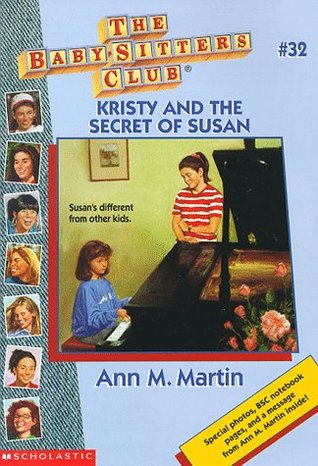April is World Autism Month (April 2nd is Autism Awareness – er, excuse me, Appreciation – Day (don’t listen to Autism Speaks), and I had recalled reading a book in the Baby-Sitters Club series, when Kristy baby-sat a young girl living with Autism.
 Kristy and the Secret of Susan by Ann M. Martin
Kristy and the Secret of Susan by Ann M. Martin
My rating: 5 of 5 stars
When I was in either third or fourth grade (memory doesn’t serve), I was intrigued by Kristy and the Secret of Susan. What is autism, I wondered? I didn’t know anyone who lived with it (it isn’t a curse, affliction, or epidemic – people do LIVE and THRIVE with it!), but the description on the back of the book made it something I wanted to read (plus, it was The Baby-Sitters Club!). I found the story fascinating as a kid, and I still find it interesting now, even knowing the progress that differently-abled individuals have made since this book was first published in early 1990.
Kristy takes on a month-long babysitting job for the Felder family’s daughter, eight-year-old Susan, who lives with autism. Her talent for the piano, memorization of the calendar and music, and perfect pitch classify her as a savant. Susan is between schools, as her parents wait for her spot at a new residential school with a music program to open up. Kristy, always the determined sort, wants to prove to the Felders that Susan doesn’t need to be away at a school, but at home, and that she could progress in the type of environment that includes her family.
In the “B-Side” story, new neighbors from Australia, The Hobarts, move in across the street from Claudia (and Mallory is smitten by the oldest brother, Ben), and face difficulties adjusting to life in the United States.
The lesson “Kristy and the Secret of Susan” aims for is acceptance and appreciation. Just because someone is different, whether it was in dress, culture, way of speaking, or doing a task, or even learning abilities, there is no need to make fun or take advantage of them. There was one particular part in the book where Kristy finds out that not everyone has the best intentions in regards to those who are different from them.
Some of the language used in the book is a tad offensive and dated, but in 1990, this was still commonplace. As a society, we’ve made progress with discussion on disabilities as a whole, but not everyone keeps up. Dialogue is always important, and despite those dated words, this book still teaches a valuable lesson.
April is Autism Appreciation Month, with April 2nd being Autism Appreciation Day. You’re supposed to “Light it Blue,” according to Autism Speaks. Unfortunately, I’ve heard more than a few disparaging things about Autism Speaks and their mission, so I’ve done “Red Instead” (thanks to a friend of mine) and taken to calling the month an “Appreciation” month, because it isn’t about awareness anymore, it is about appreciation and understanding.
Autism is tricky – it runs the gamut of functioning levels, abilities, and inabilities. There’s a reason it is called a “Spectrum Disorder” – there are people who are intellectually able (brilliant, even!), but can’t express themselves in a way individuals who are neurotypical can. There are individuals who can’t perform their normal activities of daily living, but have amazing talents that you or I don’t have. There’s speaking/expressive and sensory considerations as well. I’ve learned alot at my current job. If you’d asked me prior to 2010 to explain autism to you, I would have given a more general explanation. There is so much more. For instance, I had no idea that autism doesn’t always mean intellectually disabled. They can run together, but that is not always the case.
My best friend’s older brother (who passed away in 2016) was on the autism spectrum, but was not diagnosed until he was much older (he had an intellectual disability too). Unfortunately, because autism was not easily understood when I was coming of age (well, much less so than it is now, and it is still a mystery), it was easier to classify those with the traits of autism into a generalized group. I prefer not to use the word to describe it.
I highly recommend this book, especially when discussing disabilities (and all differences) to younger readers. This was the first time “The Baby-Sitters Club” tackled the topic of differently-abled individuals, but it wouldn’t be the last – one of the later novels I read was about Dawn baby-sitting a young girl with Down Syndrome, and Claudia forming a bond with Shea Rodowsky, who has difficulty with learning before finding out he is dyslexic. I’m glad Ann M. Martin tackled these subjects in her stories – it is important to know that not everyone is cookie-cutter – we’re all different, and those differences, talents, and abilities are to be celebrated.
I highly recommend this book!
